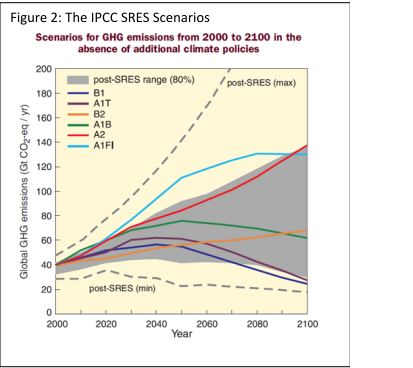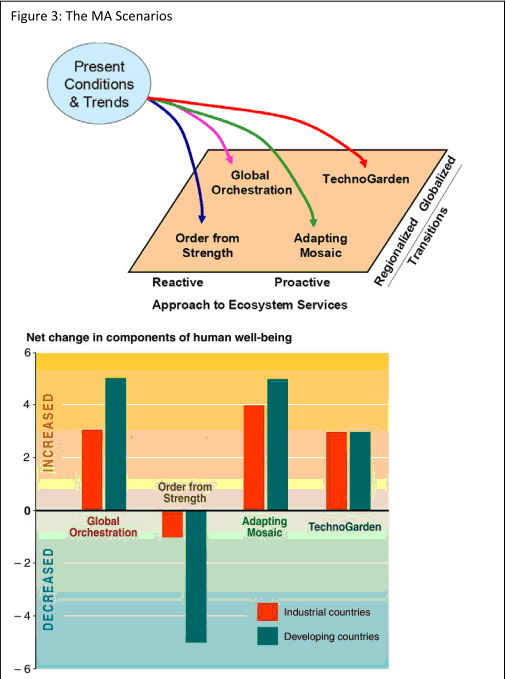Scenario development
Scenarios are “sets of plausible stories, supported with data and simulations, about how the future might unfold from current conditions under alternative human choices” (Polasky et al., 2011 [1]).
Contents
What are scenarios?
Scenarios have become important management and policy support tools. Broadly their purpose is to allow decision makers to think through the implications of different assumptions about the ways ecosystems might respond to different drivers of change (Ash et al., 2011[2]; Alcamo, 2010[3]). This is of course a difficult task because in practice it is very hard to make predictions about the future for anything other than simple, well behaved systems. Scenario thinking is therefore intended to help us cope with more complex situations involving a high degree of uncertainty (EEA, 2007[4]) (Figure 1).
As this figure suggests they sit in the ‘middle ground’ between ‘hard facts’ and robust predictions, on the one hand, and mere speculation on the other. Polasky et al. (2011[1]) have suggested that one way to think about scenario methods is that they provide us with tools to help us think creatively about the future. Many other commentators have made a similar point and suggested that in this context we must accept that there is no one way in which they might be used. Zurek and Henrichs (2007[5]) for example, have argued that scenarios can be employed to:
- Help structure choices that we need to make by revealing their possible long‐term consequences.
- Support strategic planning and decision‐making by providing a platform for thinking through the implications of various options in the face of future uncertainties.
- Helping to facilitate stakeholder participation in the strategic development process — by allowing them to voice of conflicting opinions and world views.
There are many examples of the use of scenarios. Some of the most widely discussed are those dealing with future climate change. The Special Report on Emissions Scenarios (SRES) of the Intergovernmental Panel on Climate Change (IPCC), for example, developed six potential futures, based on different assumptions about economic growth, population change, technological change, and cultural and social factors (Nakicenovic et al., 2000[6]) (Figure 2).
Other notable studies include the Millennium Ecosystem Assessment (2005[7]). The latter developed four scenarios describing alternative, global ecosystem futures based on different approaches to managing ecosystem services (proactive vs reactive) at different spatial scales (global vs regional). The scenarios made very different projections for human well‐being as it relates to ecosystem services in developed and developing societies (Figure 3).
Current Approaches to Developing Scenarios
Although scenario methods have been widely applied, their use and in particular how we might evaluate their effectiveness is still being actively discussed. On balance, the literature suggests that there is no single approach that is acceptable to all situations. This has come about because as Bradfield et al. (2005[8]) observe, many different terms have been used in association with the scenario concept, such as ‘planning’, ‘thinking’, ‘forecasting’, ‘analysis’ and ‘learning’ are all of which variously used in describing the different motives for using scenario tools. The tension between the ‘forecasting’ and ‘learning’ perspectives is particularly important to consider.
When scenarios are used to make forecasts, or projections about the future, the work generally represents scenarios as distinct ’products’. Thus for Polasky et al. (2011[1]) scenarios are essentially: “sets of plausible stories, supported with data and simulations, about how the future might unfold from current conditions under alternative human choices”. This kind of application is illustrated by the SRES and MA studies described above. In these studies the scenarios are ‘products’ in that they are well defined, general in character and capable of being taken by others and applied in different situations. Looked at in this way, scenarios are essentially quantitative or qualitative modelling exercises. Although this is a legitimate use of scenarios, other commentators have argued that scenario building can be valuable in other ways. Most importantly they suggest it can be used to facilitate social learning.
O'Neill et al. (2008[9]) have described what they see as a ‘process-perspective’ on scenarios, which emphasises the importance of them as a way of encouraging social learning within and between diverse groups. The scenario building exercise can, they suggest, help to find synergies between different viewpoints, of consensus building, and of developing shared responsibilities for problem solving. From this perspective, the scenarios products themselves are perhaps less important than the dialogue generated in their production, and the legacy that those dialogues leave. Looked at in this way, scenarios are firmly part of capacity building and training, and have strong links to the use of participatory processes.
Taking Scenarios forward
In looking to the way scenarios might be used, it is important to note that there is no single ‘right way’ but that a different approach might be appropriate in different situations. Thus it is apparent that there are many global or regional studies that have already developed scenarios that should be discussed and updated. One such study is Plan Bleu’s Sustainable Development Outlook for the Mediterranean (2005[10]), which has attempted to look at development frameworks through to 2025. Another example is the set of scenarios for the Black Sea, developed by the EnviroGRIDS project (2012[11]).
For more information, read the factsheet
Please note that others may also have edited the contents of this article.
|
References
- ↑ 1.0 1.1 1.2 Polasky, S., Carpenter, S., Folke, C., et al. (2011): Decision-making under great uncertainty: environmental management in an era of global change. Trends in Ecology & Evolution 26: 398-404.
- ↑ Ash, N, Blanco, H., Brown, C., Garcia, K., Henrichs, T., Lucas, N., Raudsepp-Hearne, C., David Simpson, R., Scholes, R., Tomich, T.P., Vira, B. and M. Zurek (Eds). (2010): Ecosystems and human well-being: a manual for assessment practitioners. Island Press
- ↑ Alcamo, J. (2001): Scenarios as tools for international environmental assessments. European Environment Agency, 1-31
- ↑ EEA (2007) Pan-European Environment: Glimpses into an Uncertain Future, EEA Report 2007-4
- ↑ Zurek, M. and T. Henrichs (2007): Linking scenarios across geographical scales in international environmental assessments. Technological Forecasting and Social Change
- ↑ Nakicenovic, N. et al. (2000): Special Report on Emissions Scenarios: A Special Report of Working Group III of the Intergovernmental Panel on Climate Change, Cambridge University Press
- ↑ MA Millennium Ecosystem Assessment (2005): Ecosystems and Human Well-being: Synthesis. Island Press, Washington, DC http://www.millenniumassessment.org Millennium Ecosystem Assessment
- ↑ Bradfield, R., Wright, G., Burt, G., Cairns, G. and M. van der Heijden (2005): The origins and evolution of scenario techniques in long range business planning. Futures, 37, 795-812
- ↑ O'Neill, B., Pulver, S., VanDeveer, S. and Y. Garb (2008): Where next with global environmental scenarios? Environmental Research Letters 3: 1-4
- ↑ Plan Bleu’s Sustainable Development Outlook for the Mediterranean: A Practitioners guide to Imagine: The systematic and prospective sustainability analysis.
- ↑ Envirogrids Project
Further Reading
Pinnegar, J., Viner, D., Hadley, D., Dye, S., Harris, M., and F. Simpson (2006): Alternative future scenarios for marine ecosystems. 1-112.


